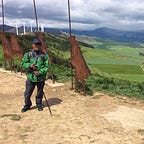Camino de Santiago in Pictures: Saint Jean Pied de Port to Burgos (Part 1)
Originating as a pilgrimage to the burial site of St. James in Galicia in the 9th century, Camino de Santiago has evolved into a journey of self-discovery, spirituality, adventure, culture and history. Approximately 300,000 people from all across the globe trek through the Camino each year. The Camino de Santiago has earned UNESCO’s World Heritage status for “Outstanding Universal Value.”
Camino Francés or the French Way that begins in the Pyrenean village of Saint Jean Pied de Port in France and ends in Santiago in Galicia, Spain, is the most popular and widely traveled of all the Camino routes. In Part 1 of my photo essay, I cover story and images from my walk on Camino Francés from Saint Jean to the city of Burgos in Castile and León, Spain. I will be presenting stories and images from the remainder of my walk to Santiago in subsequent postings.
All photos in this article were taken by the author except where noted. They represent photos from the author’s four walks on the Camino, the most recent one being in the spring of 2022.
The route of Camino Francés
St. Jean Pied de Port: Gateway to Camino Francés
St. Jean is classified as one of the most beautiful villages in France
Down the Pyrenees Valley en route Valcarlos
Valcarlos: the epic town of the ‘Song of Roland’
Wildflowers, Camino markers and beech forests serve as a welcoming backdrop to an arduous and short-of-breath climb to Roncesvalles
Roncesvalles stands at the crossroads of history, legends and witchcraft
Burguete a “street town” that Hemingway celebrated in ‘The Sun Also Rises’
Finding relief in Zubiri
Pamplona is more than just the Running of the Bulls
Summiting Alto del Perdon (Mountain of Forgiveness) where “the path of the wind crosses with the stars”
A hard descent from the summit but a rewarding view
Passage through Puenta la Reina where the paths of Camino Aragonés and Camino Francés converge
Avant-garde art and museums add a new dimension to Estella’s medieval heritage
Camino runs through the heart of Los Arcos, once a disputed land among various stakeholders
Logroño, the capital of La Rioja, provides a pleasant break to pilgrims with its culinary options, wine choices, churches and artwork
Walking across La Rioja, the birthplace of the Spanish language
Once a battleground between the Moors and the Franks, Nájera left behind a cultural legacy
From Nájera to San Domingo de Calzada, pastures, vineyards, wheat fields and vast open spaces help to put pilgrims in a reflective mood
“…But to have been this once, completely, even if only once: to have been at one with the earth, seems beyond undoing.” (Rainer Maria Rilke, Duino Elegies)
A church, a pilgrims hospital and a bridge: Santo Domingo de Calzada bears the legacy of the 11th century Saint
Grañón — the last village in La Rioja before the Camino enters the province of Burgos — offers a tranquil vibe
Murals in Belorado, a small village in Castile and Leon, celebrate women and local tradition
Treading through Atapuerca where human ancestors lived a million years ago
A chance encounter with the Cave Hermitage of Tosantos
Orbaneja Riopico: an unpretentious village offers a picture of simplicity against the backdrop of the bustling metropolis of Burgos
Flanked by the Duero and Arlanza rivers and situated right in the middle of Pilgrims Road to Santiago de Compostela, Burgos is a city of medieval splendor
Stay tuned for my upcoming postings on the Camino.
